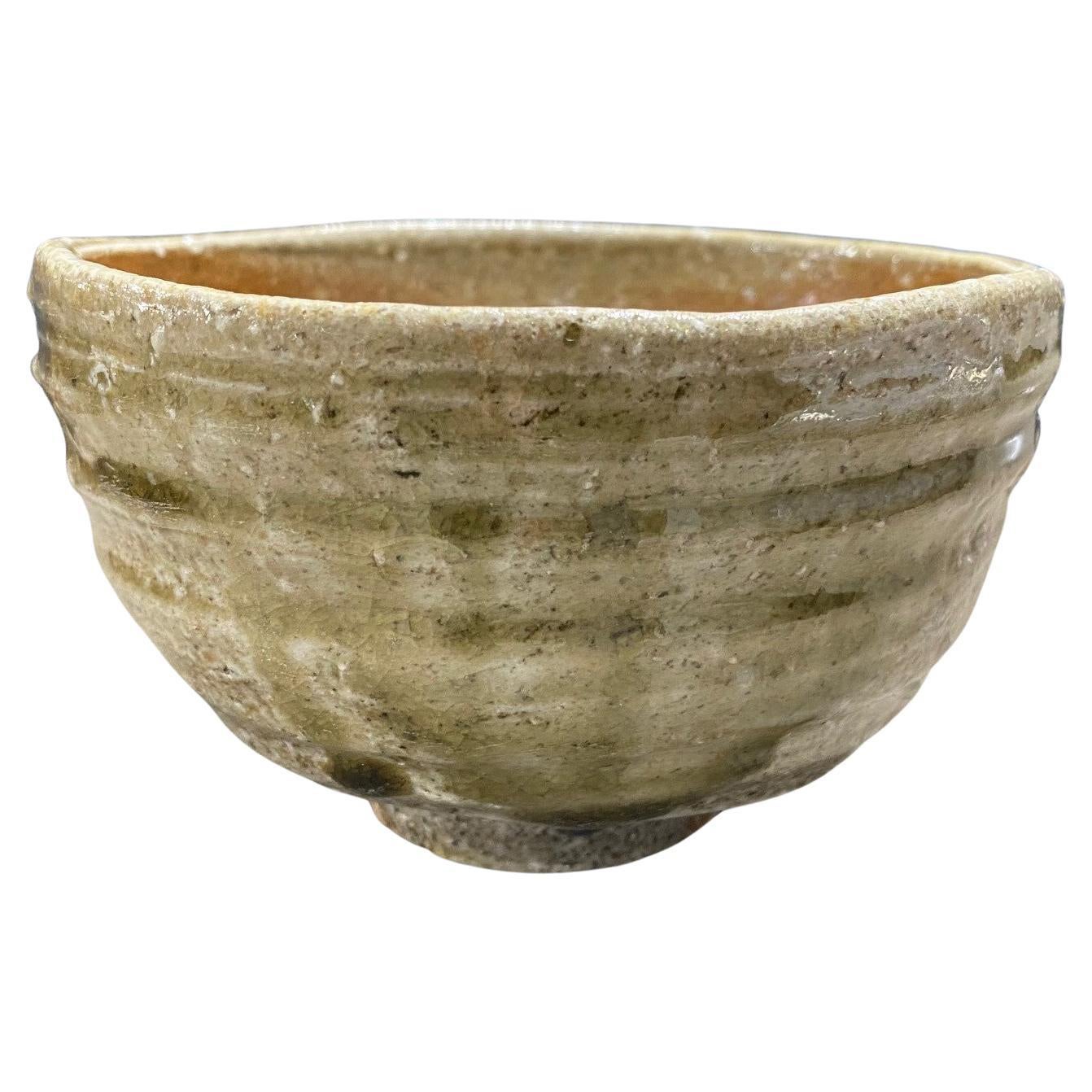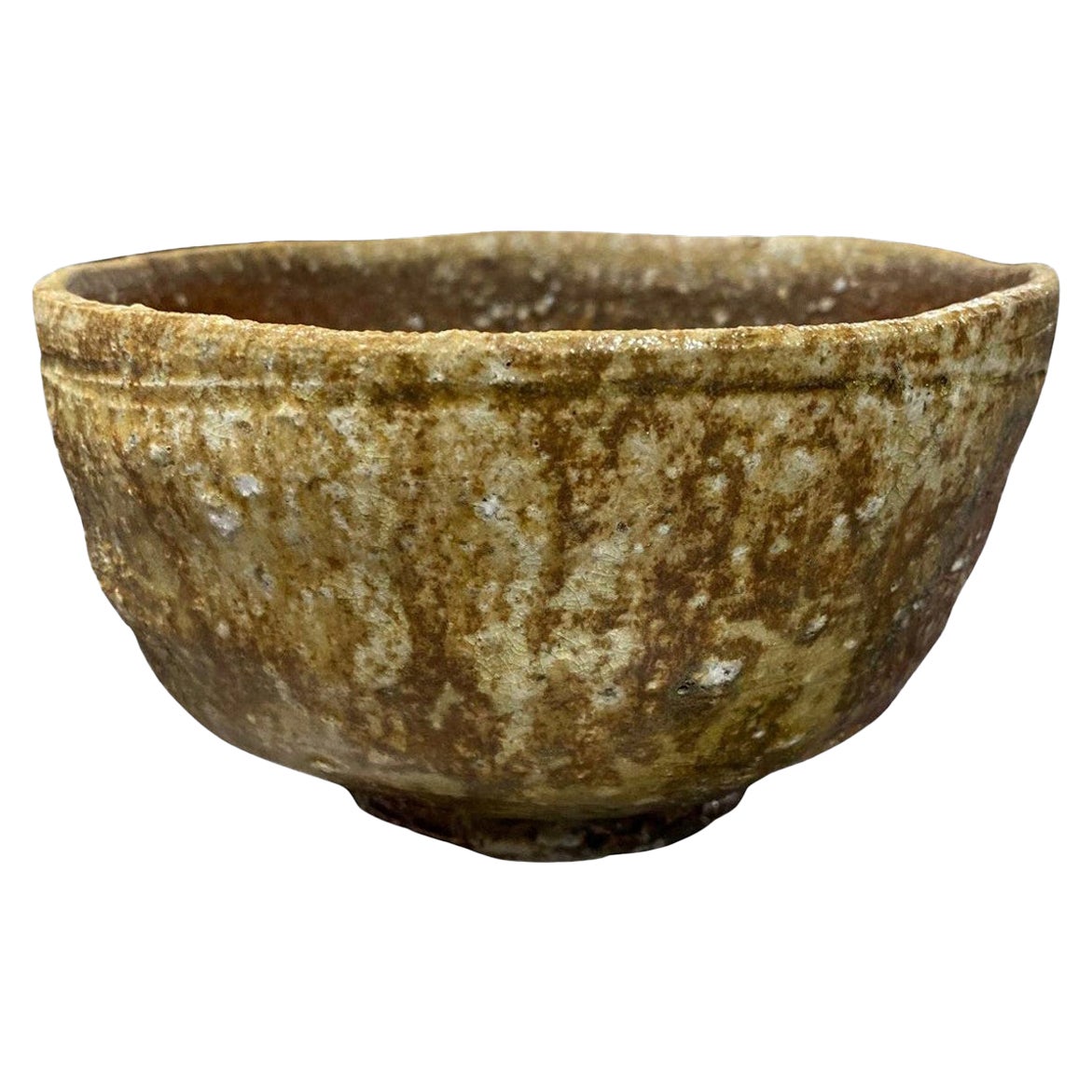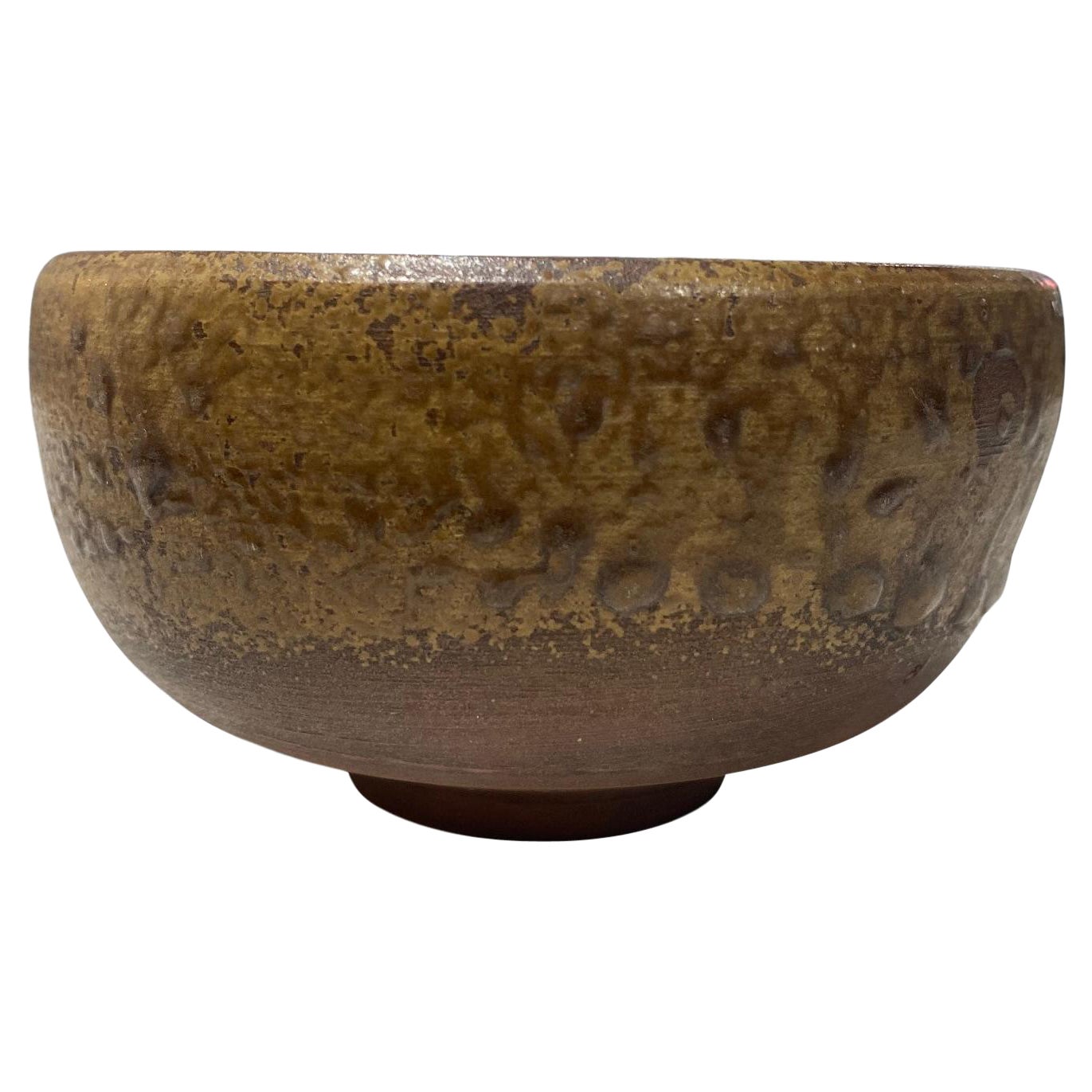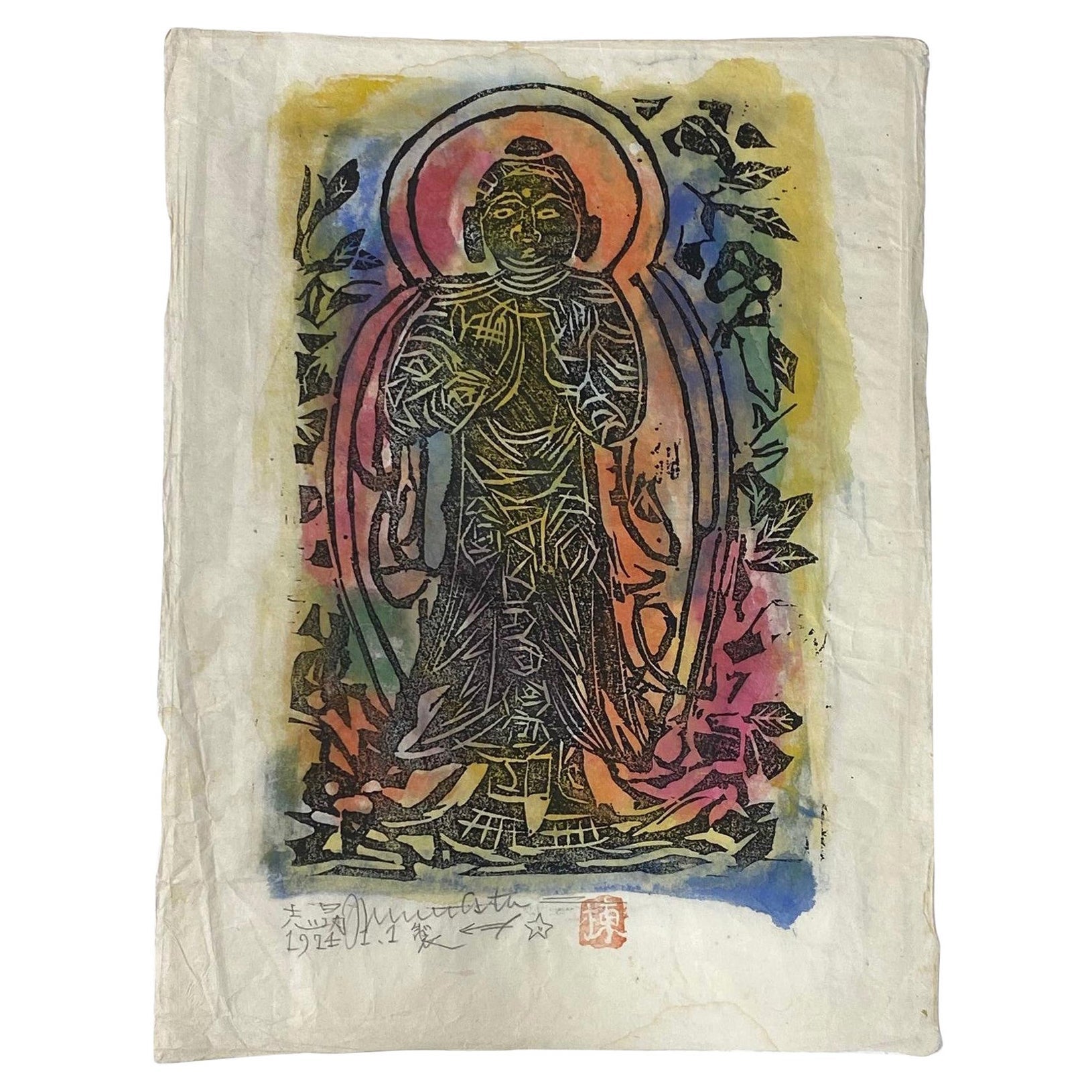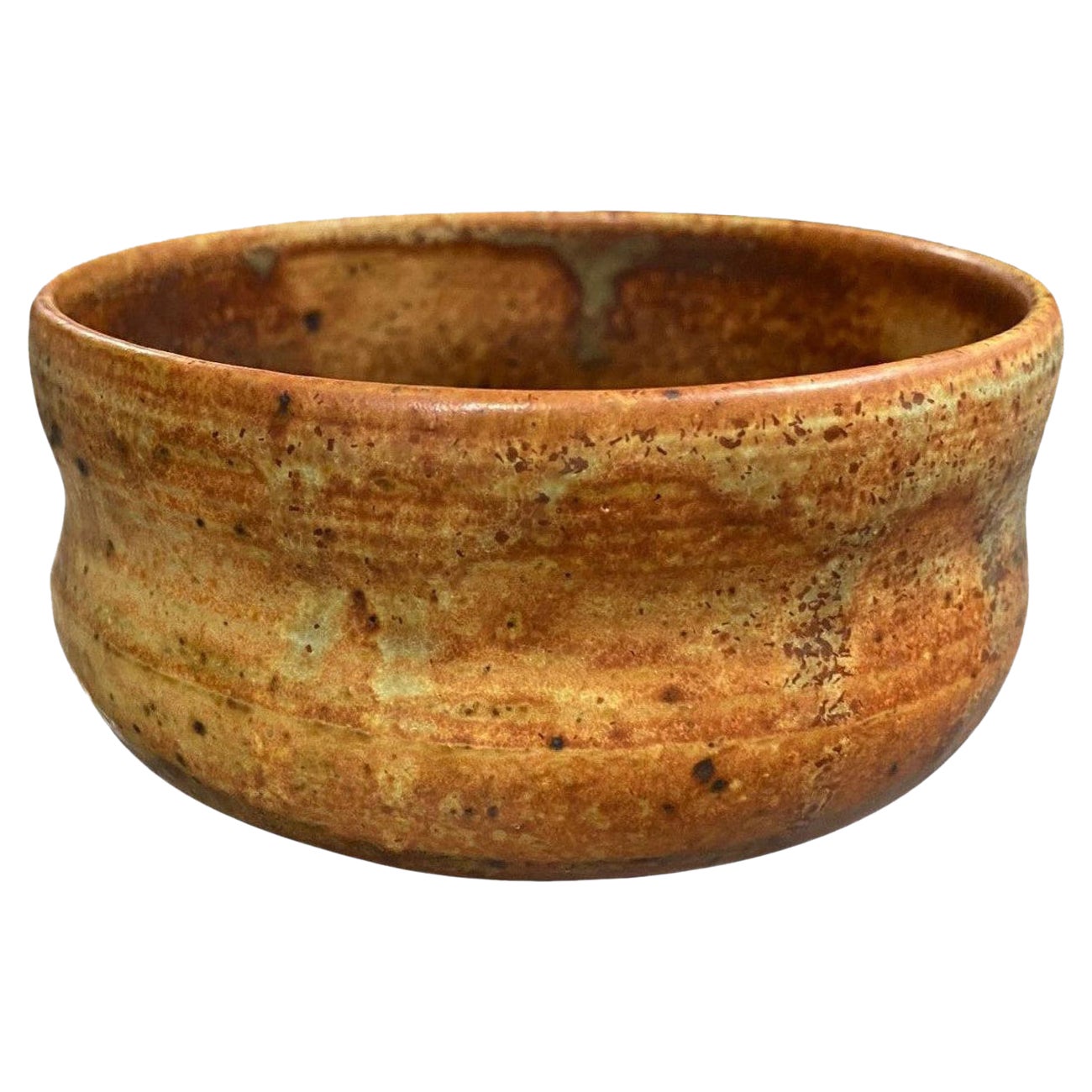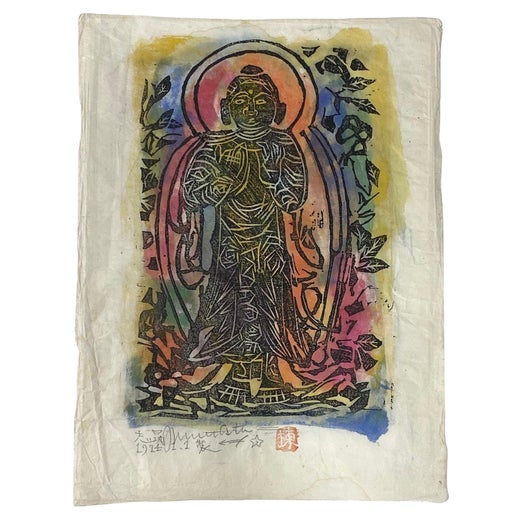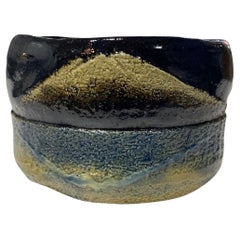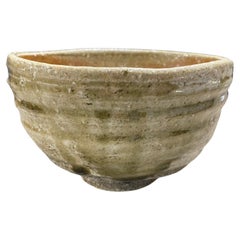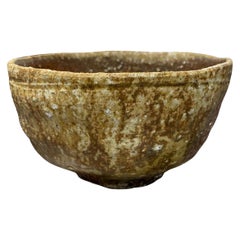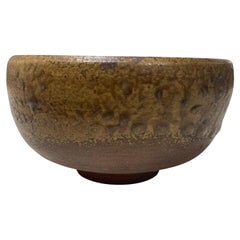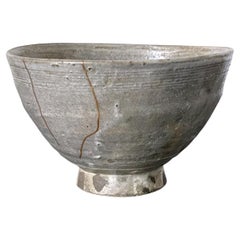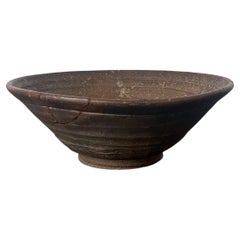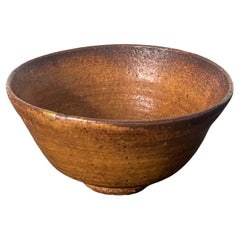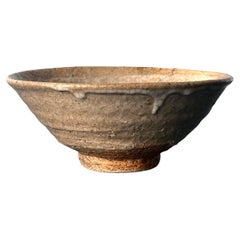Items Similar to Shiko Shikou Munakata Rare Signed Japanese Pottery Chawan Tea Bowl Signed Box
Want more images or videos?
Request additional images or videos from the seller
1 of 21
Shiko Shikou Munakata Rare Signed Japanese Pottery Chawan Tea Bowl Signed Box
About the Item
An exceptionally rare, wonderfully designed Chawan tea bowl by famed Japanese master woodblock printmaker/ artist Shiko Munakata (1903-1975) who is widely considered to be the most important Japanese visual artist of the 20th century and the Pablo Picasso of Japan. This hand-painted work clearly illustrates Munakata's whimsical side as it is of a Koma - a child's spinning top toy. Very few examples of Munakata's work in ceramics exist still today.
The work is signed by Munakata on the base as well as the original wood protective storage box (his seal can also be seen faintly in the lower-left corner).
The bowl has a small kintsugi or "golden joinery" repair - the Japanese art of repairing broken pottery by mending the areas of breakage with lacquer dusted or mixed with powdered gold - on the inside. As a philosophy, it treats breakage and repair as part of the history of an object, rather than something to disguise.
Munakata who is often compared to Picasso was primarily associated with and a principal figure in both the Sosaku-Hanga (which stressed the artist as the sole creator ) and the Mingei (folk art) movements. His many accolades and awards include the "Prize of Excellence" at the Second International Print Exhibition in Lugano, Switzerland in 1952, and first prize at the São Paulo Bienal Exhibition in Brazil in 1955, followed by the Grand Prix Award at the Venice Biennale in 1956, and the Order of Cultural Merit, the highest honor in the arts by the Japanese government in 1970. In 1960 after returning from a year abroad exhibiting his work in the United States, the Horinji Temple in Kyoto bestowed upon him the honorary rank of “Hokkyo”. In 1962, he received the rank of “Hogan” from Nisseki Temple in Toyama prefecture. He also received a Medal of Honor in 1963 and the Asahi Shimbun culture prize in 1965.
Munakata's work can be found in numerous international collections and museums including:
The Britsih Museum, UK
The Chicago Art Institute
Museum of Modern Art (MOMA), NY
The Metropolitan Museum of Art (The Met), NY
The Philadelphia Museum of Art
The Smithsonian American Art Museum (SAAM), Washington DC
Kemper Art Museum, St. Louis
And his own museum The Munakata Shiko Memorial Museum of Art located in Aomori, Aomori Prefecture, Japan.
Clearly, the bowl would be a great addition to any collectors of Shiko Munakat'a work or Japanese/ Asian ceramics/ pottery collection.
Dimensions: 2.8" high, 4.5" wide, 4.5" deep
Box: 4.5" high, 5.75" wide, 5.75" deep.
- Creator:Shiko Munakata (Artist)
- Dimensions:Height: 2.8 in (7.12 cm)Width: 4.5 in (11.43 cm)Depth: 4.5 in (11.43 cm)
- Style:Showa (Of the Period)
- Materials and Techniques:
- Place of Origin:
- Period:
- Date of Manufacture:1950s-1960s
- Condition:Repaired: Only the minor previously mentioned small kintsugi gold lacquer repair on the inside (please see photos). Very acceptable within Japanese art culture. Else pristine. The bowl is in very good vintage condition with the small kintsugi gold repair else no discernable flaws, cracks, chips etc.. Box has light, natural wear consistent with age and use (please see photos). A truly beautiful and special work overall.
- Seller Location:Studio City, CA
- Reference Number:1stDibs: LU2254328592312
Shiko Munakata
Shiko Munakata is by many regarded as one of the most significant modern Japanese artists of the twentieth century. His art work consists of paintings, prints, ceramics and calligraphy. Looking at his art work, the way he produced it and his fame, one could be tempted to call him the Japanese Picasso of the twentieth century - in every aspect. Born in Aomori Shiko Munakata was born as the son of a blacksmith in Aomori Prefecture, located in the North of Japan's main island. He first began to paint in oil as a self-taught artist. Later in 1924 he went to Tokyo to study art. Three years after the artist's death, the city of Aomori opened the Munakata Shiko Memorial Museum of Art. The museum web site has one page with a summary of the career of the artist in English. At the age of 23 Munakata Shiko saw a woodblock print by Sumio Kawakami and decided to try woodblocks himself. Under the guidance of Unichi Hiratuka he learned the art of making moku-hanga - woodblock prints. Three years later he exhibited four woodblocks at the Shunyokai exhibition. From then on Munakata Shiko was a hanga artist - a print artist. He continued to exhibit and by and by his reputation grew. After World War II had ended, the artist became famous outside Japan. His works were shown at the Lugano Print Exhibition in 1952, the Sao Paulo Biennal in 1955, the Venice Biennal in 1956. In each of these exhibitions he was awarded with first prizes. After these successful exhibition, Munakata went to the U.S., where he lectured at different universities and had numerous solo exhibitions. Munakata Shiko preferred to call his prints banga, which could be translated like picture made from a wooden panel. Munakata was a practicing Buddhist. Many of his prints and paintings show religious subjects. Other subjects are taken from Japanese legends or from nature. Munakata's prints are larger than the traditional Japanese oban (10x15 inches = 25.4x38 cm) size. With his larger-sized prints he followed Western contemporary artist's and the buying habits of Western clients. Japanese homes are usually small and have little wall space to hang art work and therefore Japanese art buyers tend to buy smaller sizes. A Munakata print is usually in black and white. The techniques he used are woodblocks, woodcuts and lithographs. Like Pablo Picasso, Shiko Munakata worked spontaneously, fast and was extremely prolific. Shiko Munakata died in Tokyo in 1975 at the age of 72.
About the Seller
5.0
Platinum Seller
Premium sellers with a 4.7+ rating and 24-hour response times
1stDibs seller since 2016
889 sales on 1stDibs
Typical response time: <1 hour
- ShippingRetrieving quote...Shipping from: Van Nuys, CA
- Return Policy
Authenticity Guarantee
In the unlikely event there’s an issue with an item’s authenticity, contact us within 1 year for a full refund. DetailsMoney-Back Guarantee
If your item is not as described, is damaged in transit, or does not arrive, contact us within 7 days for a full refund. Details24-Hour Cancellation
You have a 24-hour grace period in which to reconsider your purchase, with no questions asked.Vetted Professional Sellers
Our world-class sellers must adhere to strict standards for service and quality, maintaining the integrity of our listings.Price-Match Guarantee
If you find that a seller listed the same item for a lower price elsewhere, we’ll match it.Trusted Global Delivery
Our best-in-class carrier network provides specialized shipping options worldwide, including custom delivery.More From This Seller
View AllSasaki Shoraku III Signed Japanese Raku Pottery Chawan Tea Bowl with Signed Box
Located in Studio City, CA
A wonderful Raku-fired pottery Chawan tea bowl by a renowned Japanese pottery master and one of Kyoto’s most prominent and best-known Raku-yaki potters Sasaki Shoraku III (1944- ). The work features a beautiful image of Mount Fuji which is molded on the body.
The Shoraku line began when the grandfather of the current potter established a kiln near the famous Kiyomizu Temple, nestled at the foot of the eastern mountains...
Category
20th Century Japanese Showa Ceramics
Materials
Pottery
Rakusai Takahashi III Signed Japanese Shigaraki Pottery Chawan Tea Bowl with Box
By Takahashi Rakusai III
Located in Studio City, CA
A stunning Shigaraki ware pottery chawan tea bowl by famed Japanese master potter the 3rd Rakusai Takahashi. The bowl features a beautiful, unique natural organic ash glaze with wond...
Category
Mid-20th Century Japanese Showa Ceramics
Materials
Stoneware
Rakusai Takahashi III Signed Japanese Shigaraki Pottery Chawan Tea Bowl with Box
By Takahashi Rakusai III
Located in Studio City, CA
A stunning Shigaraki ware pottery chawan tea bowl by famed Japanese master potter the 3rd Rakusai Takahashi. The bowl features a beautiful, unique natural organic ash glaze with wonderful shifts in colour and texture.
Rakusai Takahashi III (1898-1976) is universally considered one of the most important Japanese potters of the 20th century. In 1964 he was named a human cultural treasure and bestowed a Shiga Prefectural Intangible Cultural Property. His work can be found in numerous collections and international museums including the Smithsonian's National Museum of Asian Art, and the Brooklyn Museum to name a couple.
Shigaraki Ware pottery comes from Shiga Prefecture, Japan. The kiln there is one of six ancient kilns in Japan (along with Echizen ware, Seto ware, Bizen ware, Tamba ware...
Category
Mid-20th Century Japanese Showa Ceramics
Materials
Stoneware
Kaneshige Toyo National Treasure Signed Japanese Bizen Pottery Chawan Tea Bowl
Located in Studio City, CA
A beautiful, perfectly shaped antique Bizen ware Chawan tea bowl by renowned Japanese master potter/artist Kaneshige Toyo (1896-1967) featuring a unique natural, organic forming ash glaze. Kaneshige is universally considered to be the founder of modern Bizen pottery.
In 1956, Kaneshige was certified as a Living National Treasure (Important Intangible Cultural Heritage) for his work in Bizen Ware pottery/ceramics. Bizen Ware is a type of Japanese pottery traditionally from the Bizen province, presently a part of the Okayama prefecture. It is considered one of the Six Ancient Japanese Kilns (along with Echizen ware, Seto ware, Shigaraki ware, Tamba ware, and Tokoname ware).
The piece is signed/ sealed on the base with one of Kaneshige's traditional incised marks.
A rather engaging and scarce work. Would be a fantastic addition to any Japanese/Asian pottery or Bizen Ware collection or eye-catching stand-alone work in about any setting.
Kaneshige's work can be found in numerous prominent collections and museums including:
Aichi Prefectural Ceramic Museum, Seto, Japan
Brooklyn Museum, NY
Hagi Uragami Museum, Yamaguchi, Japan
Honolulu Art Museum, HI
Ibaraki Ceramic Art Museum, Kasama, Japan
Indiana Art...
Category
Mid-20th Century Japanese Showa Ceramics
Materials
Stoneware
Shiko Shikou Munakata Signed Japanese Woodblock Buddha Bodhisattva Print
By Shiko Munakata
Located in Studio City, CA
A wonderful Mingei woodblock print featuring the Buddha or Bodhisattva by famed Japanese master Showa era printmaker/ artist Shiko Munakata (棟方志功 ) who is regarded by many as one of ...
Category
20th Century Japanese Showa Prints
Materials
Paper
Japanese Asian Signed Studio Pottery Wabi-Sabi Ceramic Glazed Chawan Tea Bowl
Located in Studio City, CA
A gorgeous Japanese studio pottery chawan tea bowl that features a wonderful reddish-orange glaze with various shifts in colour and texture.
This particular piece encompasses the...
Category
20th Century Japanese Showa Ceramics
Materials
Earthenware
You May Also Like
Korean Gohon Chawan Tea Bowl for Japanese Market Joseon Dynasty
Located in Atlanta, GA
A ceramic chawan (tea bowl) circa 17-18th century fired in the Busan kiln in Korean specifically for the Japanese market. The kilns were run by the So c...
Category
Antique 17th Century Japanese Edo Ceramics
Materials
Ceramic
Korean Ceramic Kakinoheta Chawan Tea Bowl
Located in Atlanta, GA
A "Kakinoheta" type ceramic chawan (tea bowl) made in Korean during Joseon dynasty circa 16th-17th century. The bowl has a slight irregular flat shape w...
Category
Antique 17th Century Korean Other Ceramics
Materials
Ceramic
Korean Ceramic Irabo Tea Bowl Chawan Joseon Dynasty
Located in Atlanta, GA
A ceramic chawan tea bowl made in Korea for Japanese market circa 17th century. The chawan is identified as Irabo type. Irabo bowls were essentially con...
Category
Antique 17th Century Korean Other Ceramics
Materials
Ceramic
Korean Ceramic Ido Tea Bowl Chawan Joseon Dynasty
Located in Atlanta, GA
A ceramic stoneware chawan tea bowl made in Korea circa 16-17th century. The chawan is identified as Ko-ido (small ido) due to its size and form. Ido bowls were made since 15th centu...
Category
Antique 17th Century Korean Other Ceramics
Materials
Ceramic
Antique Korean Mishma Tea Bowl Chawan Joseon Dynasty
Located in Atlanta, GA
A Korean Hori-Mishima Chawan (tea bowl) circa 16th-17th century (Joseon Dynasty). The tea bowl is of an upright conical form supported by a high foot ring. It was decorated with incised brushwood fence patterns filled with white slip on both the interior and exterior surface. These dominant motifs were spaced by three encircling double lines. Seven chrysanthemum flowers (inka) were stamped on the lower interior surrounding a swirling tea well on the bottom. There are six spur marks known as Meato in Japanese on the interior bottom and a pointy spot in the center of the foot ring known as Tokin. Two crack lines were historically repaired by superb Kintsugi, adding a mysterious wabi-sabi appeal to the piece.
The Hori-Mishima bowl was also known as Gohon Mishima. It was made in Bushan Kilns of the Southern Gyeongsang Province specifically for the Japanese market in the 16th-17th century, when the tea ceremonies in Japan demanded such ware. The bowl comes with a purple fabric pouch...
Category
Antique 17th Century Korean Other Ceramics
Materials
Ceramic
Glazed Ceramic Chawan Tea Bowl by Toshiko Takaezu
By Toshiko Takaezu
Located in Atlanta, GA
A small elegant glazed ceramic tea bowl (chawan) by Japanese American artist Toshiko Takaezu (American, 1922 - 2011). The well-balanced form is hand built and shows just a slight irr...
Category
Late 20th Century American Modern Decorative Bowls
Materials
Ceramic
Recently Viewed
View AllMore Ways To Browse
Japanese Wood Sign
Switzerland Ceramics
Signed Artist Bowl
Repaired Ceramics
1950s Art Pottery
Arts And Crafts Ceramics American
Arts And Crafts Uk
Signed Hand Painted Bowl
Spinning Top
Asian Storage Box
Signed Japanese Pottery
Pottery Bowl Japan
Japanese Bowl Signed
Painted Wide Bowl
Brazilian Vintage Ceramics
Signed Wood Bowl
American Arts And Craft Pottery
Japanese Joinery

